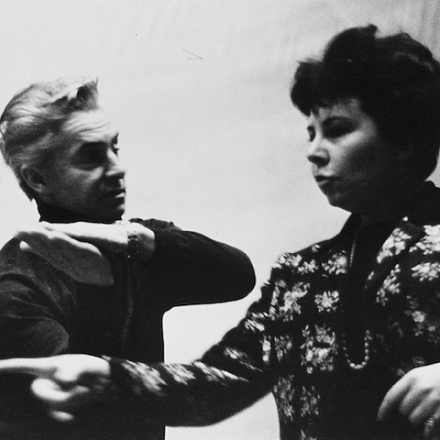Herbert von Karajan started conducting Mahler in 1955 when he performed Lieder eines fahrenden Gesellen. Those performances were given in the United States – Chicago and New York – and over the next quarter of a century, despite a narrow interest in the composer, he would become one of its greatest interpreters. He would conduct his first Das Lied von der Erde in 1960 and would in total give thirteen concerts of it (four of which exist from broadcasts) and make one studio recording, in 1973, for Deutsche Grammophon. It remains one of the finest performances of it, but as is so often the case with Karajan one has to turn to his live concerts to find this conductor at his most inspired.
The recording here – originally issued on a Hunt CD from Italy – is unique, not just for Karajan, but for the Das Lied von der Erde discography too. Given in Berlin on 14th December 1970, from a series of concerts that month, it is the only version to use two tenors and one soprano. None of Karajan’s cycles of this work from 1960 attempted this arrangement, and there is even a slight irony as to why he should have done so in 1970; he engaged some of the greatest tenors to sing the part in 1960. His soprano for all of the concerts then – the first one with the BPO at the end of February in Berlin, the second with the VPO in the middle of March and the sole concert on 26th June to mark the centenary of Mahler’s birth – also with the VPO – all used Hilde Rössel-Majdan. His tenors, however, were hardly second rate: Sándor Kónya for the Berlin ones, Fritz Wunderlich for Vienna and Anton Dermota for the Mahler Centenary.

Wunderlich – unless he was having an off day – has generally come closer than most tenors to singing the part in Das Lied von der Erde most successfully. His recording with Klemperer is outstanding, although it was made when Wunderlich was slightly older and his voice at the height of its powers before his sudden death. But, as with almost all recordings of this magnificent work it is the tenor which proves most problematic to cast. The number of distinguished – and undistinguished – tenors who are crushed by the occasional insurmountable difficulty of these songs is quite remarkable.
There are, of course, multiple possibilities for this song cycle and there are recordings which reflect this. Tenor and alto is the most common; but tenor and baritone has been favoured by some (notably Kletski and Bernstein). Most recently, Jonas Kaufmann has sung both.
Karajan’s solution in 1970 was to divide the part into a lyric tenor and one who was closer to a Heldentenor. Karajan might have stamped rather more authority on the idea if he had chosen rather better tenors than he did; the quality of the performance here is not as strikingly brilliant as I’m sure he intended it to be. It is, I’m afraid, not immediately apparent which tenor is singing which song – neither Ludowic Spiess nor Horst Laubenthal are especially distinctive singers, though we can largely guess which is which because of where the music lies. More notable as a Bach specialist, and the more lyric of the two, Laubenthal sits more comfortably in the terrain of ‘Trunkene’. Spiess, a Romanian, whose vocal chords would eventually suffer irreparable damage, is the more dramatic – kindling some of the weight he brought to another Das Lied von der Erde, this one with Janet Baker and Rudolf Kempe in 1975. But the lack of colour in the voices and the blandness of the expression is rather bleak for this work. Both Spiess and Laubenthal struggle with Mahler’s writing, too. Spiess is unsettling at the top – the wobble becomes quite intrusive at times. Laubenthal lacks confidence at the bottom, however. It is not ideal, and I don’t think either tenor is helped by Karajan’s tendency to plough through parts of the score like a bulldozer.
Christa Ludwig is adequate compensation for a performance which both stutters between its movements and can seem rushed by its conductor. Ludwig would appear on Karajan’s studio recording in 1973, and she would also appear on his finest live performance which was given on 27th August 1972 in Salzburg. The tenor on both was René Kollo – and if only he had been on this 1970 recording it may have been a very different performance indeed. Christa Ludwig, who would appear on so many recordings of Das Lied (Bernstein, Kleiber, Klemperer and Neumann to name just a few) is almost the polar opposite of her tenors and Karajan. She aligns much more closely to the Berliners, too, who despite Karajan’s oblivious indifference at times are wonderfully expressive. The tonal warmth, the range of her expression, her ability to elicit such profundity in ‘Der Abschied’ is in a parallel universe to the rest of this performance.

Karajan would never return to this arrangement for Das Lied von der Erde again. There has, to my knowledge, never been another performance which has used three singers either. However, if my recollection is correct Bruno Maderna and Jascha Horenstein exchanged letters about performing Das Lied using exactly this version. It never bore fruit, however; both would die in 1973.
The coupling for this Urania set is a live Karajan Mahler Fifth. Dated 1973 only, this is not particularly helpful since Karajan gave three performances of the symphony that year – two in February and one in August. However, this is the 28th August performance given at the Salzburg Festival so far as I can tell from comparing the Urania performance here with the 1973 broadcast from March and the FKM CD from August (although the very bright recording is a close hint as well).
Karajan had an extremely rigid way of performing the Mahler symphonies he conducted and rarely deviated from that. Often they were based around the recordings he made for DG; indeed, this was the case for many works he would only ever play once. He only conducted the Fourth in 1980; the Ninth in 1982, for example. He seems to have been drawn to Mahler’s Sixth and Mahler’s Fifth in a rather different way performing both symphonies over a five-year period.
Karajan is most often heard through his studio recordings, but an entirely different picture emerges of him through his concerts. His live Mahler is no exception to this. The big perception we have of Karajan is that he was obsessively perfect. His live performances throw caution to the wind in ways which are quite surprising, however. As beautiful as the Berlin Philharmonic sound in this Fifth the playing – especially the brass – can be quite insecure. In part this has to do with Karajan’s willingness to push tempos more aggressively than he tends to in the studio and to accent the lines with more danger. The second movement is wonderfully stormy – the imbalance tipping the scales towards the kind of dramatic impulses you don’t hear in his studio Fifth. The tension is as tight as a drum; climaxes explode with devastating force. What Karajan also brings to this Fifth is power – the Berliners have tremendous heft; strings are muscular, brass imposing.
Karajan takes a touch longer over the Adagietto than many conductors (eleven minutes) but it’s one of the finest you’ll hear. The gift of keeping the music flowing is entirely in Karajan’s hands and he doesn’t falter for a second in keeping it moving like a slow flood of scorching lava. The intensity is extraordinary; the beauty of the Berlin strings unrivalled right up to that final pianissimo which fades into such serenity it just vanishes.
It’s easy to get lost in the Rondo of the Fifth. A lot of performances not only start off with a sense of inhibition they also sound slack; it’s a similarity it shares with the last movement of Nielsen’s Fourth Symphony and which also traps many conductors. Karajan’s tempos are fast; he grabs you by the scruff of your neck and drags you with him through a little under fifteen minutes of music and you never quite have time to catch a breath between bar rests. The coda is one of the most wild and exciting on disc (interestingly taken with slightly less of the rubato he used in his March performance which pulled back on the sheer devilry of the ending). It’s unquestionably a great Fifth.
The sound on both performances is variable. The 1970 Das Lied von der Erde is in rather distant mono and although there is no difficulty hearing any of the details in the music the acoustic is drier than one would wish. Urania’s transfer of the Mahler Fifth (in stereo) suffers to some degree from the same problem as the FKM CD release – poor track editing. The Urania is significantly worse, however; the track pause between the Adagietto and the Rondo is several seconds long; on the FKM that problem has been eliminated. The Urania has been transferred at a much brighter level, too, and with rather more tape noise. However, the FKM is now out of print, and the Urania is more than satisfactory to hear what is a sensational Fifth – even if the 1970 Das Lied von der Erde remains something of a curiosity.
Marc Bridle
Karajan Live Vol.2: Herbert von Karajan (conductor), Berliner Philharmoniker
Gustav Mahler: Das Lied von der Erde
Christa Ludwig (alto), Ludowic Spiess (tenor), Horst Laubenthal (tenor) Recorded in Berlin, 14th December 1970
Gustav Mahler: Symphony No.5
Recorded at the Salzburg Festival, 28th August 1973
Urania CP131535 [2:15:49]